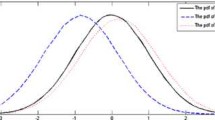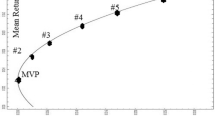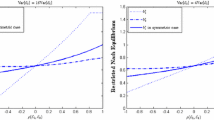Abstract
In this article, we provide a link between the Shapley value in cooperative game theory and the capital asset pricing model (CAPM) in finance. In particular, the Shapley value of a suitably defined cooperative game is closely related to the beta factor in the CAPM. The beta factor for any given security may be interpreted as the asset’s fairly allocated share of the market risk or as the asset’s average marginal contribution to the market risk, respectively. Other fairness properties and axioms of the Shapley value may be reinterpreted in this context to attain a deeper understanding of the beta factor and the connotation of systematic risk. Our game theoretic approach further allows for a generalisation of the CAPM with respect to arbitrary risk measures other than variance. Last but not least, we discuss the volatility of an asset’s theoretical fair assessment of risk and of its systematic risk, respectively. This result lends itself to face the challenge of an empirical investigation on real stock markets.
Similar content being viewed by others
References
Acerbi, C., Tasche, D.: On the coherence of expected shortfall. J. Bank. Finance 26, 1487–1503 (2002)
Aumann, R.J.: Value of markets with a continuum of traders. Econometrica 43, 611–646 (1975)
Aumann, R., Shapley, L.S.: Values of Non-Atomic Games. Princeton University Press, Princeton (1974)
Artzner, P., Delbaen, F., Eber, J.M., Heath, D.: Coherent measures of risk. Math. Finance 9, 203–228 (1999)
Buch, A., Dorfleitner, G.: Coherent risk measures, coherent capital allocations and the gradient allocation principle. Insur.: Math. Econ. 42, 235–242 (2008)
Castro, J., Gomez, D., Tejada, J.: Polynomial calculation of the Shapley value based on sampling. Comput. Oper. Res. 36, 1726–1730 (2009)
Csóka, P., Herings, P.J.J., Koczy, L.A.: Stable allocations of risk. Games Econ. Behav. 67(1), 266–276 (2009)
Csóka, P., Herings, P.J.J.: Risk allocation under liquidity constraints. J. Bank. Finance 49, 1–9 (2014)
Csóka, P., Pinter, M.: On the impossibility of fair risk allocation. B.E. J. Theor. Econ. 16, 143–158 (2016)
Denault, M.: Coherent allocation of risk capital. J. Risk 4, 7–21 (2001)
Fischer, T.: Risk capital allocation by coherent risk measures based on one-sided moments. Insur.: Math. Econ. 32, 135–146 (2003)
Kalkbrener, M.: An axiomatic approach to capital allocation. Math. Finance 15, 425–437 (2005)
Kargin, V.: Uncertainty of the Shapley value. Int. Game Theory Rev. 33, 959–976 (2005)
Markowitz, H.: Portfolio selection. J. Finance 7, 77–91 (1952)
Moretti, S., Patrone, F.: Transversality of the Shapley value. Top 16, 1–41 (2008)
Owen, G.: Multilinear extensions of games. Manag. Sci. 18, 64–79 (1972)
Pinter, M.: Regression games. Ann. Oper. Res. 186, 263–274 (2011)
Samuelson, P.A.: The fundamental approximation theorem of portfolio analysis in terms of means. Var. High. Moments Rev. Econ. Stud. 37, 537–542 (1970)
Shapley, L.S.: A value for n-person games. In: Kuhn, H.W., Tucker, A.W. (eds.) Contributions to the Theory of Games, Volume II (Annals of Mathematics Studies 28), pp. 307–317. Princeton University Press, Princeton (1953)
Sharpe, W.: A simplified model for portfolio analysis. Manag. Sci. 9, 277–293 (1963)
Sharpe, W.: Capital asset prices: a theory of market equilibrium under conditions of risk. J. Finance 19, 425–442 (1964)
Young, H.P.: Monotonic solutions of cooperative games. Int. J. Game Theory 14, 65–72 (1985)
Author information
Authors and Affiliations
Corresponding author
Appendix
Appendix
Proof of Lemma 1
Note that the set of symmetric \((n\times n)\)-matrices is a linear vector space. A basis is given by the set of symmetric basis matrices \(E_{ij} \) having coefficients
These matrices are obviously linear independent. Note that the number of such linear independent matrices is \(\left( {\begin{array}{l} n \\ 2 \\ \end{array}} \right) +n=\frac{n(n+1)}{2}\) . It is equal to the dimension of the vector space of symmetric \((n\times n)\) matrices. By means of an illustration, for \(n=3\) said basis is given by
For a fixed market portfolio M, the set of capital market games \(\Gamma =\left( {M,v_A } \right) \) is a linear vector space, too, if we apply point-by-point addition and scalar multiplication of characteristic functions. Note that the basis games \((M,v_{E_{ij}})\) are exactly the unanimity games with at most 2 relevant players. By means of an illustration for \(n=3\), we see that \(v_{E_{12} } \left( {\{1,3\}} \right) =v_{E_{12} } \left( {\{2,3\}} \right) =v_{E_{12} } \left( {\{1\}} \right) =v_{E_{12} } \left( {\{2\}} \right) =v_{E_{12} } \left( {\{3\}} \right) =v_{E_{12} } \left( \varnothing \right) =0\) and \(v_{E_{12} } \left( {\{1,2,3\}} \right) =v_{E_{12} } \left( {\{1,2\}} \right) =2\). We then easily deduce that \(\Phi _1 (M,v_{E_{12} } )=\Phi _2 (M,v_{E_{12} } )=1\) and \(\Phi _3 (M,v_{E_{12}})=0\).
In general, we observe that for any basis game, it holds true that
Now, for any given symmetric matrix \(A=(a_{ij} )\), the linear combination  is known. It follows that the characteristic function is given by
is known. It follows that the characteristic function is given by  . By linearity of the Shapley value, it is true that
. By linearity of the Shapley value, it is true that
where we have used the Kronecker delta: \(\delta _{ik} =1\) for \(i=k\) and \(\delta _{ik} =0\) otherwise. \(\square \)
Proof of Lemma 2
The starting point for the computation of the volatility is its definition as per Eq. (9):
First we note that
In addition, it holds true for any marginal difference with \(S\subseteq M,i\in S\) that
It follows that
Using the abbreviations \(|S|=s\) and \(|M|=n\), we note that
Likewise, it holds true that
In addition, we see that
Putting it all together, we find that
\(\square \)
Rights and permissions
About this article
Cite this article
Ortmann, K.M. The link between the Shapley value and the beta factor. Decisions Econ Finan 39, 311–325 (2016). https://doi.org/10.1007/s10203-016-0178-0
Received:
Accepted:
Published:
Issue Date:
DOI: https://doi.org/10.1007/s10203-016-0178-0




